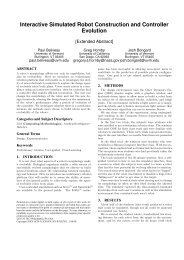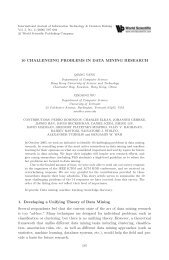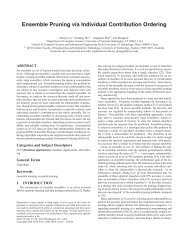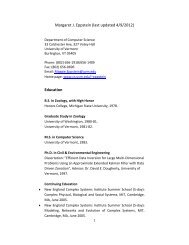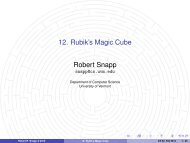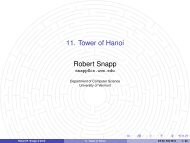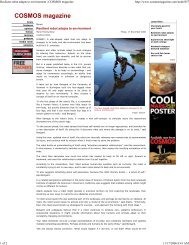Darwin's robots - Computer Science - University of Vermont
Darwin's robots - Computer Science - University of Vermont
Darwin's robots - Computer Science - University of Vermont
- No tags were found...
You also want an ePaper? Increase the reach of your titles
YUMPU automatically turns print PDFs into web optimized ePapers that Google loves.
TECHNOLOGY< with natural organisms, suchas symmetry and the repetition<strong>of</strong> modules.Josh Bongard, who works onrobot evolution at the <strong>University</strong><strong>of</strong> <strong>Vermont</strong> in Burlington, saysClune’s approach is excitingbecause it explores how a robot’sbody affects its behaviour and<strong>of</strong>fers control over the evolution<strong>of</strong> every aspect <strong>of</strong> a robot – brain,body and behaviour.“If CPPNs are used to evolverobot bodies along with brains, hemay be able to evolve <strong>robots</strong> withcomplex bodies as well ascomplex brains,” Bongard says.Using evolutionary methods tobuild whole robotic entities opensup an even more intriguingpossibility – that <strong>robots</strong> couldevolve new and entirely differentstructures. “It may well be that theneural networks and bodies thatwe create for the system are notthose that the system woulddevelop for itself,” says JamesGiordano, who directs the Centerfor Neurotechnology Studies inArlington, Virginia.Better robotic bodies that canhandle the brain’s demands arecertainly needed: the test robotbroke down because it was unableto cope with the running motionsthat the brain had evolved after anumber <strong>of</strong> generations.Eventually, the brain and bodyshould work in concert, with thebrain’s evolution dependent uponwhat tasks the robot carries outduring its lifetime, says Jean-Baptiste Mouret <strong>of</strong> the IntelligentSystems and Robotics Institute inParis, France.“The brain will depend on thebody and on the ‘life’ <strong>of</strong> the robot,in the same way as birds’ brainsare different from rats’ brains,”says Mouret. Breeding <strong>robots</strong> thatcan do more than walk is the nextbig step. The s<strong>of</strong>tware-basedbrains that are best at performinga desired behaviour in simulation,such as climbing a wall or gettingclose to a person, will be allowedto reproduce until the finalgeneration has hard-wiredinstincts to perform the task. nSmart app scansbrain on the flyA portable EEG scanner could make life a loteasier for people with neurological problemsJacob AronYOU can now hold your brain inthe palm <strong>of</strong> your hand. For thefirst time, a scanner powered by asmartphone will let you monitoryour neural signals on the go.By hooking up a commerciallyavailable EEG headset to a NokiaN900 smartphone, Jakob EgLarsen and colleagues at theTechnical <strong>University</strong> <strong>of</strong> Denmarkin Kongens Lyngby have createda completely portable system.This is the first time a phonehas provided the power for anEEG headset, which monitorsthe electrical activity <strong>of</strong> the brain,says Larsen. The headset wouldnormally connect wirelessly to aUSB receiver plugged into a PC.Wearing the headset andbooting up an accompanyingWall-climbing,base-jumping,paragliding robotADRENALIN junkies, step aside: anew base-jumping robot can climbup buildings before deploying aparaglider to fly back down to earth.And it has its own on-board videocamera to record the jump.The remote-controlled robot,named Paraswift, is a collaborationbetween Disney Research and theSwiss Federal Institute <strong>of</strong> Technology(ETH) in Zurich, and was initially builtto entertain visitors to theme parks.But as the first compact robot thatcan both climb and fly, it has practicaluses too, such as gathering aerialfootage for 3D modelling systems.app designed by the researcherscreates a simplified 3D model<strong>of</strong> the brain that lights up asbrainwaves are detected, andcan be rotated by swiping thescreen. The app can also connectto a remote server for moreintensive number-crunching,and then display the results onthe cellphone.“Traditionally, in order to dothese kind <strong>of</strong> EEG measurementsyou have big lab set-ups that arereally expensive,” says Larsen.“You have to bring people in,isolate them and give themspecific tasks.” The smartphoneEEG would let researchers studypeople’s brain signals in morenatural environments such as athome or in the workplace. Teamscan also use the smartphone’sother features to conductIt uses an impeller – a rotorspinning in a tube – to create a vortexthat sticks it to the wall as it climbs.“It’s like a mini tornado within therobot,” says ETH student LukasGeissmann, who presented Paraswiftlast week at the Conference onClimbing and Walking Robots in Paris,France, with Paul Beardsley <strong>of</strong> DisneyResearch. The centre <strong>of</strong> this vortex islow pressure, just like the eye <strong>of</strong> atornado, and the higher atmosphericpressure around it pushes the robotonto the wall.“The big benefit is that you don’tneed a seal between the robot andthe wall because the vortex forms itsown seal around the low-pressurearea,” Beardsley says. That meansonly the robot’s wheels need touchthe wall, and it can navigate the <strong>of</strong>tenrough surfaces <strong>of</strong> buildings.ClassicStock / AlamyThis is one <strong>of</strong> the major challengesin designing wall-climbing <strong>robots</strong>,says Metin Sitti <strong>of</strong> the CarnegieMellon <strong>University</strong> Robotics Institutein Pittsburgh, Pennsylvania: “It isvery difficult to have a robustattachment mechanism that couldwork on a wide range <strong>of</strong> smooth andslightly rough surfaces in real-worldconditions,” he says.Mobile <strong>robots</strong> are increasinglyused to inspect dangerous or hard-toreachstructures such as windturbines, dams and tall buildings.Most commonly, they use magneticadhesion, but that limits a robot t<strong>of</strong>errous structures. Others use“A mini tornado withinthe robot creates a vortexthat sticks it to the wallas it climbs”24 | NewScientist | 17 September 2011
For more technology stories, visit newscientist.com/technologyOne Per CentEPA/SHAMSHAHRIN SHAMSUDIN/corbis–No hospital required–suction or grips, but <strong>of</strong>ten comeunstuck on rough surfaces.A novel mechanical carbon-fibrearm deploys the paraglider, which ismade <strong>of</strong> parachute material attachedto struts. Once the paraglider is open,the vortex is switched <strong>of</strong>f and theexperiments such as displayingpictures or videos that elicit aspecific brain response, ormonitoring groups <strong>of</strong> people asthey work together on a task.The system might also assistpeople with conditions such asepilepsy, attention-deficithyperactivity disorder andaddiction by cutting down on thenumber <strong>of</strong> hospital visits theyneed to make, in the same way thathome-based heart monitors do.“Our vision is for EEG tobe a regular thing that you haveat home,” says ArkadiuszStopczynski, who worked on theproject with Larsen. “It’s muchbetter than going to the lab,sitting there for 1 hour <strong>of</strong> EEGand going home.”“The realisation <strong>of</strong> a real-timebrain-mapping system on acellphone is a nice task,” saysGunther Krausz <strong>of</strong> G.Tec MedicalEngineering, a firm based inSchiedlberg, Austria, whichsupplies EEG systems toresearchers. But as a research tool,he says, the phone can’t comparewith dedicated medical devices.“You need sophisticatedstimulation devices and dataprocessing”,which cannot bedone with the app alone. nrobot simply falls <strong>of</strong>f the wall andinto flight, filming as it falls. At themoment, the paraglider is deployedby remote control, but the teamwants to automate the process sothat it can deploy immediately shouldthe robot fall. Catherine de Lange n–Leave it to the <strong>robots</strong>–Social network based on your bowelsMove over Facebook, there’s another social network in town.And this one knows its users inside out. MyMicrobes aims tobring together individuals with the same gut flora so thatthey can share questions and concerns about their digestivehealth. To join, you must provide a stool sample by post –along with $2100 to cover the cost <strong>of</strong> having the DNA <strong>of</strong>your gut bacteria sequenced. The site <strong>of</strong>fers a way to meetpeople with similar gastrointestinal complaints and sharedigestive anecdotes with one another. Yes, it’s pretty niche.In exchange, the researchers behind the scheme will gathera wealth <strong>of</strong> data about the bacteria that live in peoples’ guts.Hybrid air travel for the ArcticTravel in the Arctic is notoriously difficult, and climate changeis making it even harder as rising winter temperatures meanvital ice roads melt earlier. But there is a way to rise above theproblem: the latest generation <strong>of</strong> lighter-than-air vehicles.Canadian firm Discovery Air has signed a contract with theUK’s Hybrid Air Vehicles to buy about 45 hybrid air vehiclesto be used across Canada’s Northwest Territories. HAVs arenot strictly airships. They use the inert gas helium for lift,but lift also comes from their aerodynamic design. They cancarry 50 tonnes if they take <strong>of</strong>f like an aeroplane and around30 tonnes if they take <strong>of</strong>f vertically.Navigate using virtual mirrorsYou know the feeling. You’ve arrived in a new city and thatdistant church spire you were using to navigate by seemsto have disappeared from view. Wouldn’t it be useful if youcould peek around corners in the hope <strong>of</strong> spotting somethingelse you recognise? That’s the thinking behind MirrorMap,an augmented reality system developed by Carmen Au andcolleagues at McGill <strong>University</strong> in Montreal, Canada. Hold up asmartphone running the app and you’ll see video feeds fromCCTV cameras in the area appear as “virtual mirrors” hangingin space, helping you to get your bearings.For breaking tech news go to:newscientist.com/onepercentNisian Hughes/getty17 September 2011 | NewScientist | 25




